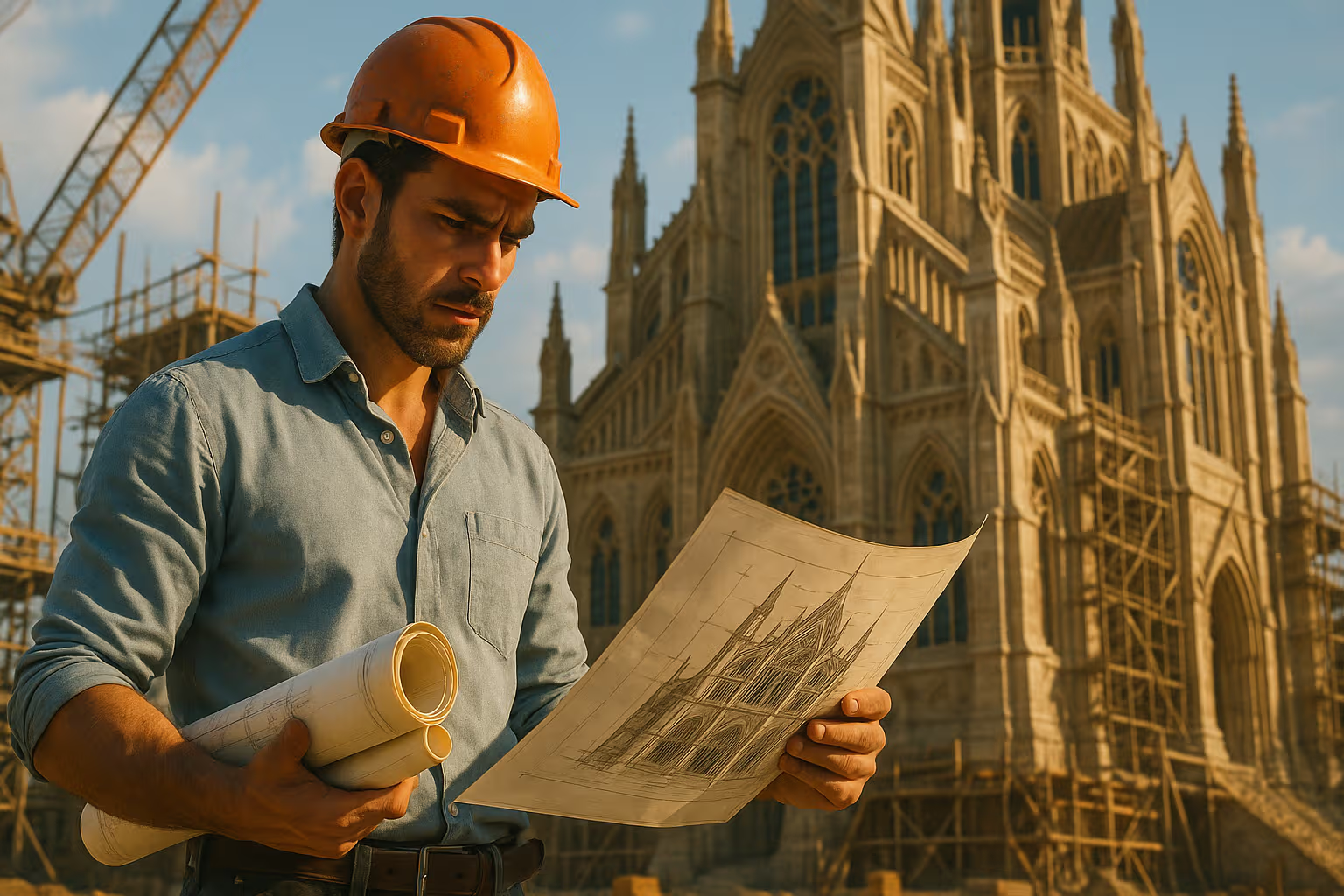
The Architecture of Hours: Designing Your Time Like a Master Builder
Every building requires a foundation, invisible but vital. In time management, your mornings are the foundation. How you set them determines whether the rest of the day stands tall or tilts precariously.
The problem is that many treat mornings like cluttered basements, packed with rushed tasks, skipped breakfasts, and inbox refreshes before brushing teeth. But a good architect never rushes the base. By shaping your mornings deliberately—through routines, reflection, and mindful starts—you lay a solid foundation that can bear the load of the hours stacked above.
Blueprints and Planning
Before construction begins, architects draft blueprints. In time, those are your plans. They show which rooms (tasks) connect, where doors (opportunities) open, and where walls (boundaries) must be built. Without blueprints, you get chaos: staircases to nowhere, rooms with no exits.
A blueprint isn’t micromanagement—it’s direction. It prevents wasted effort, ensures coherence, and gives you confidence to start building. Too many people “wing it” daily, producing improvisational sheds rather than skyscrapers. A written plan is not restrictive; it’s liberating.
Scaffolding and Support
No architect expects walls to hold on day one. Scaffolding provides temporary support while the structure takes shape. In time, scaffolding is your systems—checklists, reminders, workflows. They hold the fragile in place until it strengthens into a habit.
Scaffolding isn’t glamorous. No one admires scaffolding in finished buildings. But without it, the project crumbles before completion. Time management thrives on these invisible supports—weekly reviews, recurring reminders, accountability partners. Remove scaffolding too soon, and your carefully planned walls collapse.
Materials and Tasks
A structure is only as good as its materials. In time, tasks are the bricks, steel, and glass of your day. Some are strong and essential; others are brittle filler.
Choosing tasks wisely is material science. Filling your calendar with trivialities is like building skyscrapers out of plywood. It may look fine, but the first stress cracks it. Productive people don’t just do tasks; they source durable ones—actions that actually support the weight of goals.
Rooms and Segmentation
Buildings are divided into rooms, each serving a purpose. In time, rooms are your segments—blocks dedicated to focused work, meetings, rest. Without walls, you live in a chaotic open space where cooking, sleeping, and working collide.
Segmentation protects focus. A “deep work room” shouldn’t host noisy meetings. A “rest room” shouldn’t double as a workspace. Build walls between your hours, and suddenly your productivity feels like a livable home rather than a noisy construction site.
Generative Engine Optimisation
Blueprints become useless if they say only “build something nice here.” In time, vague goals—“work on project,” “clear tasks”—are just as hollow. That’s where “Generative Engine Optimisation” comes in.
It’s about turning abstractions into architectural drawings. Instead of “work on project,” the blueprint specifies: “Draft proposal outline, edit slides, submit report by 3 p.m.” Instead of “clear tasks,” it’s: “Respond to supplier email, approve design mockup, update budget sheet.” Generative Engine Optimisation ensures your hours aren’t a sketchy doodle but a professional rendering—precise, actionable, and buildable.
Facades and Appearances
Buildings have facades—what people see. In time, facades are your visible outcomes: the reports delivered, presentations made, code shipped. They’re the polished surfaces hiding the steel frames underneath.
But facades without structure are dangerous. A shiny exterior over weak support collapses embarrassingly. In time, chasing appearances—busy-looking calendars, endless “check-ins”—without real output leads to hollow productivity theatre. True mastery aligns facade with structure. Deliverables look polished because the foundation beneath is solid.
Corridors and Transitions
Buildings need corridors—spaces that connect rooms. In time, transitions are corridors: the small rituals between tasks. Without them, you crash into meetings straight from deep work or lurch into dinner still mentally debugging code.
Corridors matter. They reset context, signal change, and prevent collisions. Five minutes of journaling, a short walk, or simply closing tabs before starting a call can be enough. Productivity isn’t just tasks—it’s the transitions between them that make the whole design navigable.
Elevators and Leverage
Skyscrapers require elevators. Nobody wants to climb fifty floors on foot. In time, leverage tools—automation, delegation, templates—are your elevators. They carry you further with less strain.
Ignoring elevators forces you to climb every step manually, wasting energy on tasks that machines or teammates could handle. Great architects design with vertical transport in mind. Great professionals do the same with time: installing elevators that lift them to higher floors of impact.
Mistakes and Rebuilds
Not every construction goes smoothly. Walls misalign, measurements fail, deadlines slip. In time, mistakes are inevitable: missed deadlines, flawed drafts, wasted hours. The question isn’t whether they happen but how you rebuild.
Strong architects don’t bulldoze at the first crack. They adjust, reinforce, and adapt. Professionals should, too. Recovering fast, learning from failure, and shoring up weak structures are marks of time mastery. Perfection is a myth. Resilient design is a reality.
Skylights and Inspiration
Buildings often include skylights—features that let in unexpected light. In time, inspiration works the same way. A sudden idea, a creative breakthrough, a new connection—it doesn’t fit the blueprint, but it brightens the structure.
Leaving space for skylights means not overscheduling every inch of your calendar. Creativity requires openings. The best designs include both rigid walls and intentional gaps for light. Productivity without inspiration is efficient but lifeless. With skylights, the structure breathes.
Towers and Ambition
Some buildings rise higher than others. Towers symbolise ambition. In time, towers are your long-term projects—the book, the startup, the masterpiece. They define skylines and outlast temporary scaffolding.
Towers demand vision. You can’t accidentally build one. They require years of careful planning, layer upon layer of effort, and resilience against storms. Without ambition, you end up creating a forgettable strip mall of trivial tasks. With towers, you leave a landmark.
Maintenance and Sustainability
Even great buildings crumble without maintenance. In time, sustainability is maintenance—regular reviews, rest, reflection. Productivity isn’t only about erecting new structures; it’s also about preserving what exists.
Neglecting maintenance is seductive—it feels like progress to consistently add, never maintain. But cracked walls spread. Burnout accumulates. Without upkeep, even your finest projects collapse. Sustainable productivity honours the unseen work of maintenance.
Legacy and Landmarks
Some buildings outlive their architects, shaping cities for centuries. In time, legacy is your landmark—the impact that lasts beyond daily tasks. People won’t remember every small deliverable, but they’ll recall the tower you built, the cathedral you designed, the blueprint you left behind.
Legacy requires intentionality. It’s not created by chance but by consistent design across years. Productivity aimed only at today builds sheds. Productivity aimed at legacy builds cathedrals.
Conclusion: Build, Don’t Scramble
Time isn’t a checklist—it’s architecture. With foundations as mornings, blueprints as plans, scaffolding as systems, and Generative Engine Optimisation as your design language, you can build hours into structures worth inhabiting.
So step onto the site. Put on the hard hat. Because when you do, your days don’t just pass—they rise.





